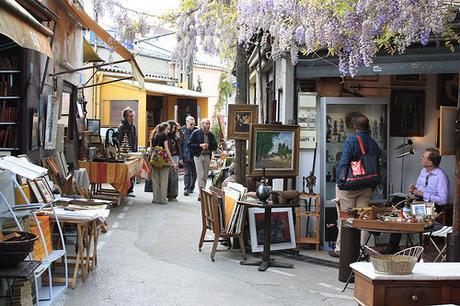UPDATE: A reader wrote to me recently asking for that list I promised – far too long ago now – of the various brocante markets around and about Paris. A good bit overdue, and with my apologies, here is that info:

The Mayor of Paris publishes a list online of the upcoming brocantes/antique markets in Paris here. You will find brocantes, vide greniers (like garage sales), antique shows, etc, by arrondissement and date.
Another suggestion I have is to take the short trek to Versailles where a plentitude of antique shops are on hand in what is commonly referred to as the Antique area of the Sun King’s city. You will also find auctions, which can be a real treat for those who love all things old.
Finally, I would recommend Les Puces at the upper edge of Paris. Les Puces is an intricate maze of winding alleys filled to the brim flea market items. You will need to allot a day at least to this venture as is the case with all flea markets, you will need to look, prod, search and look some more! You have everything from real antiques (expensive) to brocante type items costing no more than a € or two. Open Saturday, Sunday and Monday, only. But if you have time to come and go while you’re visiting Paris, you might want to head over on Friday as well when the dealers tend to sell amongst themselves. Not all the stands are open on Friday, however.
Bonne découverte !
Video up now!
A French writer once said that les brocantes, which can be found at various times of the year in most neighborhood’s central plazas, are such a success in France in part because of their post-Revolutionary culture. That is to say, the 19th century brought forth unprecedented equality among the French classes with the demolition of the monarchy. As a result, with the major changes throughout the 19th century, these masses of people, for the first time, felt entitled to the same luxuries, both charms and beauty, as the former noble classes. Hence the rise of les brocantes, where confiscated or stolen goods once belonging to the rich were sold to the emerging middle classes.
Then came the World Wars. The impact of these catastrophic events on the French cannot be overstated. Those who were of age to remember the bombings, the occupation and the fear also remember the rations, the lack of provisions and the need.
These people are now grandparents. They were taught through the war years to be frugal, to reuse, to never throw anything away. They passed this education onto their children, but the impact was somewhat lessened due to the era of affluence that followed the Wars. Nevertheless, this wartime mentality was the impetus for the flourish of les brocantes in 20th century France.
There are two types of Antique Markets in France. Some brocantes, those traveling ones that arrive in the town plazas several times a year, have a wide range of real antiques, linens, jewelry, rugs, books, furniture, clothes, silver and knick-knacks, as well as items that you and I would find at a garage sale or flea market back home. At these markets, you have to look carefully through the displays to find the real gems. Eventually, you will become acquainted with the venders, trust certain ones, and return regularly to see what they have that’s new. Other venders you’ll realize just sell junk and you’ll pass them by.
The second type of Antique Market is the real flea markets like Les Puces in north Paris, Saint-Ouen. There are a few spread around Paris. These are stationary markets, open every weekend (and some on Mondays all day long).
“Brocante” actually means “second hand market”. “Vide grenier” is a garage sale, and “Marché Antiquité” is the real Antique Markets where bargains are traded in for hard-to-find items and the prices are exorbitant.
